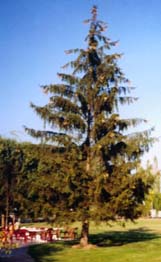PHENIX
Hard Scattering PWG
-
``Measurement of hard $\pi^0$ in
inclusive, central and peripheral Au+Au collisions---Discovery of QCD
Energy loss in Hot Dense Matter.''
The assumption is that year one running with a full EM calorimeter in a
single arm with recorded live integrated luminosity of 20 inverse
microbarns should allow measurements of inclusive pizeroes to beyond 6
GeV/c in transverse momentum. Impact parameter dependence as a function
of Zcal or E_T should also be posible although the rate for peripheral
collisions may be inadequate. It is assumed that no trigger is
available for the first year. The main problems are expected to be
calibration, efficiency, and combinatoric background. In future years
with higher luminosity, triggers using EMcal clusters are possible and
desirable.
-
``Search for prompt photons in
inclusive, central and peripheral Au+Au collisions---limits on
$\gamma/\pi$ for p_T < 10 GeV/c.''
Absent any new phenomenon such as a ``flash of photons'' or strong jet
quenching in a Quark Gluon plasma, it is unlikely that a prompt photon
signal will be able to be significantly extracted from the collossal
background of photons from pizero and eta decays. The prompt
photon/pizero ratio increases with increasing $p_T$ which means the
signal can only be seen at large $p_T$ which usually means high
luminosity. This physics is limited both by background and by rate.
Non-linearity in the EM calorimeter is also crucial. It is vital, for
instance, that two 3 GeV photons have the identical response as one 6
GeV photon. Extensive studies of photon/pizero separation from EM
cluster algorithms and combinatoric problems such as false pairing of a
candidate photon with a random photon to make a pizero, or loss of a
real pizero by the same mechanism are required.
-
``Measurement of $\pi^+$, $\pi^-$
at large p_T in inclusive, central and peripheral Au+Au Collisions''
Possibility of other hadrons, flavor tagging of jets a la CCHK ? Should
have the same sensitivity as the pizero measurement in year one if the
tracking coverage is the same as the EMcal. The issue for tracking is
the ability to reconstruct tracks with high resolution at resonable
efficiency. Triggers are possible and desirable in later years using
pions above the RICH threshold (> 4 GeV/c).
-
``Measurement of correlations of
charged particles/$\pi^0$ with all `hard' probes above in inclusive,
central and peripheral Au+Au collisions''
Di-hadron measurements require full tracking and/or EMcal in both
central arms and suffer a reduction in rate of roughly a factor of 6
(not counting p_T cuts) compared to inclusive single particle rates.
Here's where we can measure the `acoplanarity' and energy imbalance of
`jets', i.e. the ``k_T'' and ``x_E'' distributions.
-
``Measurement of Shadowing of the
Gluon structure function in Au+Au Collisions''
from the rate of inclusive high p_T muons from heavy quark decay. This
requires a single working muon arm and should produce a useful
measurement with the year-1 luminosity. Problems are reconstruction
efficiency, resolution and background. Evidently, understanding the
background has a high priority to prove that the single muons are from
heavy quark decay rather than light quark decay or punchthrough.
-
``Drell-Yan production of
di-leptons as a function of centrality in Au+Au collisions''
This process is rate limited since it is essentially an electromagnetic
process produced by hadron constituents. Thus high luminosity and a
trigger are required which are not likely in year-1. An interesting
issue that can be addressed in PHENIX is the associated multiplicity
and $E_T$ (the impact parameter dependence) for drell-yan production.
The steeply falling mass spectrum and point-like scaling observed in
p-p and p+A collisions also make Drell-Yan pairs a sensitive probe to
search for energy loss of quarks and anti-quarks in the initial state
of cold nuclear matter.
General Questions for Above Reactions
- What should we expect: $A$ dependence for
Central/Peripheral/inclusive with and without Quenching, Cronin Effect,
Estimate sensitivity to energy loss vs $\int {\Cal L} dt$
- What can PHENIX do? What beams, lums are needed?
- $k_T$ or $p_T^2$ vs $E_T$ in p+A, A+A: what is known, what do we
expect for RHIC, with and without QGP, quenching?
- Based on our present knowledge what measurements can/should we
make for p-p, p+A,B+A,Au+Au (vs $\sqrt{s}$) vs $\int {\Cal L} dt$,
 Michael J. Tannenbaum 7/28/99 - contact: mjt@bnl.gov
Michael J. Tannenbaum 7/28/99 - contact: mjt@bnl.gov
 Michael J. Tannenbaum 7/28/99 - contact: mjt@bnl.gov
Michael J. Tannenbaum 7/28/99 - contact: mjt@bnl.gov